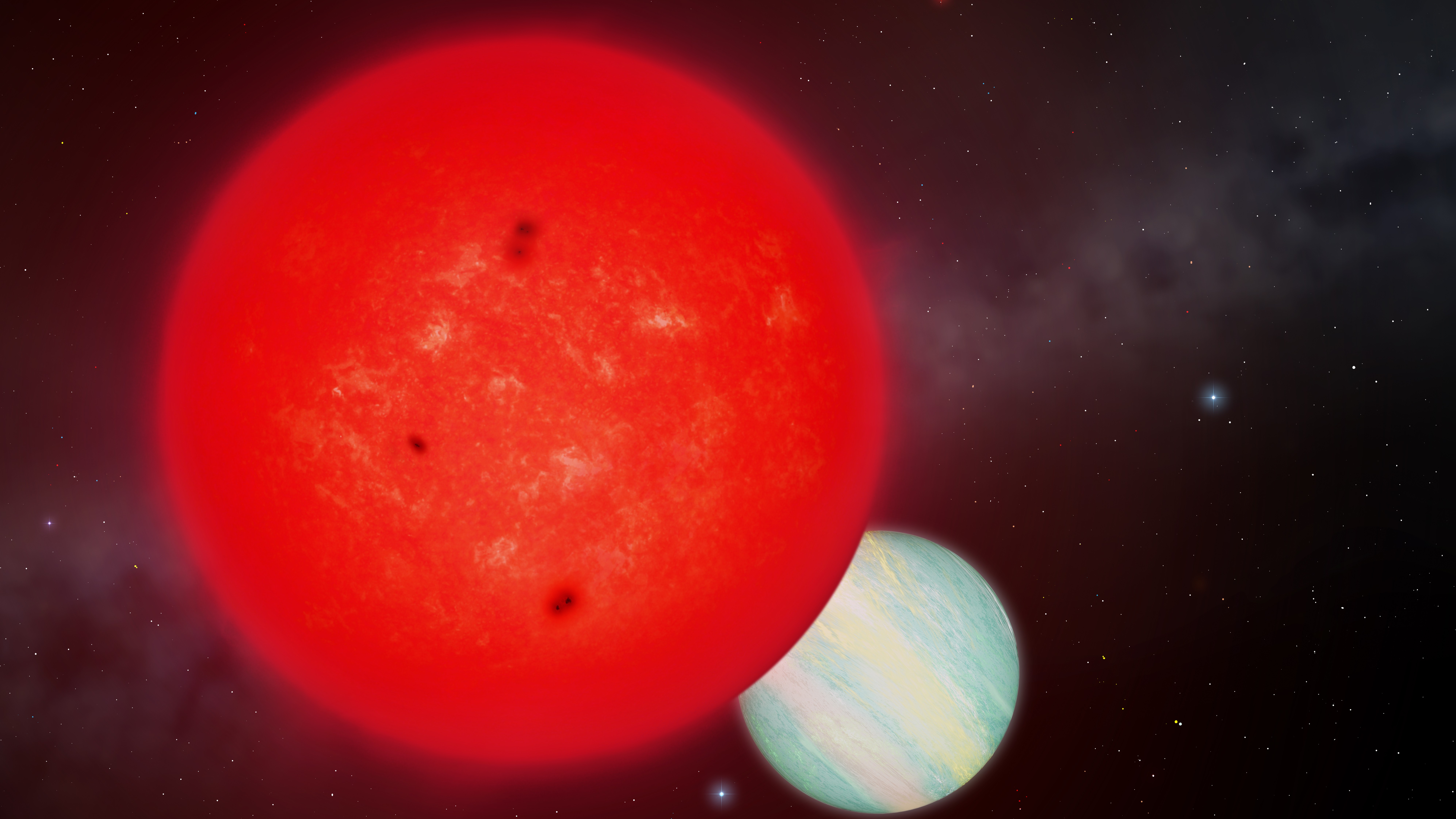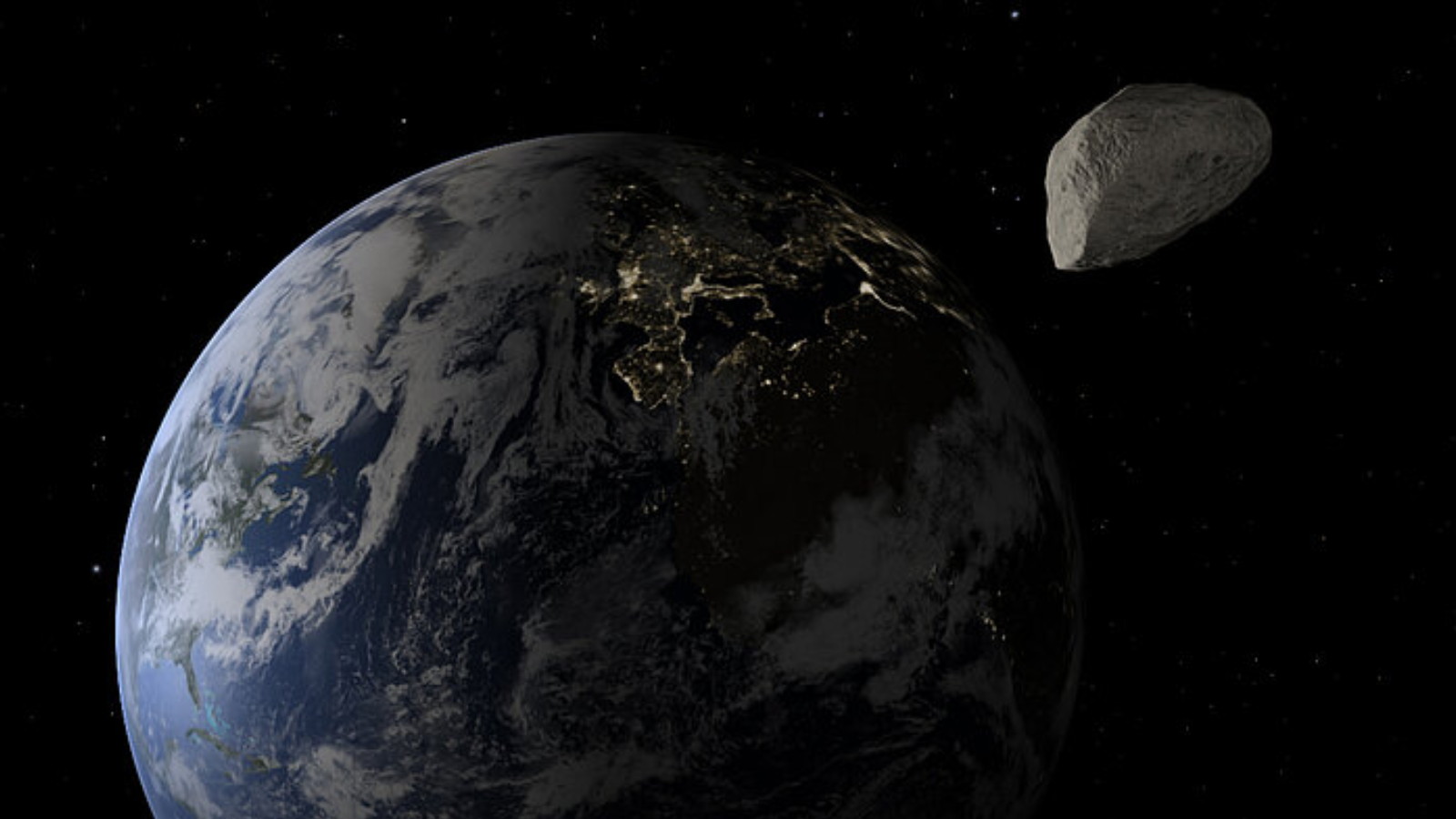A tiny star gave birth to a giant exoplanet, but no one knows how

Like a family in which short parents have tall children, a tiny red dwarf star is defying our understanding of how planets form by existing alongside a giant exoplanet.
Giant planets are not rare per se — after all, we have four in our own solar system. Such large worlds are, however, rarely found around the smallest stars, red dwarfs. Red dwarfs simply shouldn't have enough material to form such huge worlds.
Well, tell that to the red dwarf star TOI-6894, which is located 238 light-years away. It has just 20% of the mass of the sun, but has been found to host a giant planet, TOI-6894b, that's a little larger than Saturn, albeit with only about half the mass of the ringed planet.
Statistical work has shown that only about 1.5% of red dwarfs harbor gas giant planets, so TOI-6894 is among a rare breed indeed. And it is by far the least massive star to be found with an orbiting giant planet: 60% less massive than the next lowest-mass star with a gas giant.
Given how scarce such worlds around red dwarfs are, finding this new planet in data from NASA's Transiting Exoplanet Survey Satellite (TESS) was not easy. (The "TOI"' in the system's name refers to a "TESS object of interest.")
"I originally searched through TESS observations of more than 91,000 low-mass red dwarf stars looking for giant planets," Edward Bryant of the University of Warwick, who led the discovery, said in a statement.
Upon discovering that TESS had recorded TOI-6894b transiting its star, which gave Bryant the planet's radius, his team then observed it with the ESPRESSO (Echelle Spectrograph for Rocky Exoplanets and Stable Spectroscopic Observations) spectrograph on the Very Large Telescope in Chile, and SPIRou (Spectropolarimétre Infrarouge) spectrograph on the Canada–France–Hawaii Telescope on Mauna Kea to determine its mass.
Breaking space news, the latest updates on rocket launches, skywatching events and more!
However, "we don't really understand how a star with so little mass can form such a massive planet," team-member Vincent Van Eylen of University College London's Mullard Space Science Laboratory said in the statement
There are two models to describe the formation of giant planets. One way, which we think is how Jupiter, Saturn, Uranus and Neptune formed, is via a process called core accretion. A giant planetary core, up to ten times the mass of Earth, forms first out of elements heavier than hydrogen and helium. The gravity of the resulting large rocky body is then able to pull in huge swathes of gas in a runaway process from the surrounding planet-forming disk.
Given that red dwarfs are scaled down stars, the material available in their planet-forming disk is then similarly scaled down — hence why we find many more smaller planets around red dwarfs than gas giants. Calculations suggest the core of TOI-6894b contains 12 times the mass of Earth. However, in a previous survey of 70 planet-forming disks around red dwarfs with between 15 and 25% the mass of our sun, only five were found to contain more than 12 Earth masses of heavy elements, and only one had an abundance significantly greater than 12 Earth masses. The odds are that TOI-6894b shouldn't have been able to support core accretion.
However, Bryant has tried to envisage a process of core accretion by halves. Given that TOI-6894b's overall mass is less than Saturn, a runaway accretion process might not have been required to build up its mass.
"Given the mass of the planet, TOI-6894b could have formed through an intermediate core-accretion process, in which a protoplanet forms and steadily accretes gas without the core becoming massive enough for runaway gas accretion," he said.
An alternative means by which giant planets form is from a disk instability, whereby a section of a planet-forming disk becomes unstable and collapses under its own gravity, coalescing into a planet. This is a top-down formation process rather than the bottom-up of core accretion, but there is disagreement within the astronomical community over whether such low-mass stars can even experience a disk instability.
So, the origin of TOI-6894b remains an open question, but the James Webb Space Telescope (JWST) could potentially discover the answer in the planet's atmosphere.
TOI-6894b orbits close to its star every 3.37 days at a distance of just 3.89 million kilometers (2.42 million miles). A gas giant so close to a sun-like star would be classed as a "hot Jupiter" with an atmospheric temperature in the high hundreds, if not more than a thousand, degrees Celsius. However, as a red dwarf, TOI-6894 is cooler than our sun by more than 2,500 degrees Celsius, meaning TOI-6894b has an atmospheric temperature of just 147 degrees Celsius (296 degrees Fahrenheit) – still warm, but by no means hot. This has repercussions for the chemistry of its atmosphere.
"Based on the stellar irradiation of TOI-6894b, we expect the atmosphere is dominated by methane chemistry, which is very rare to identify," Amaury Triaud of the University of Birmingham said in the statement. "Temperatures are low enough that atmospheric observations could even show us ammonia, which would be the first time it is found in an exoplanet atmosphere."
A proposal to observe TOI-6894b's atmosphere has already been accepted as part of the JWST's fourth cycle of science observations, to take place over the next 12 months. Besides searching for the likes of methane and ammonia, the characteristics of the planet's atmosphere discernible to JWST could point to which formation model – core accretion or disk instability – is the correct one, or even whether a brand new formation model is needed.
Although giant planets around red dwarf stars are rare — other examples include the worlds LHS 3154b, GJ 3512b and c, and TZ Ari b — the numbers may still be on their side. That's because red dwarfs are the most common type of star in the galaxy, making up three-quarters of the estimated 100 billion stars in the Milky Way. So even 1.5% of 75 billion is a huge number of red dwarf stars – 1.125 billion to be exact — that could host giant planets.
"This discovery will be a cornerstone for understanding the extremes of giant planet formation," concluded Bryant.
The discovery of TOI-6894b was published on June 4 in the journal Nature Astronomy.

Keith Cooper is a freelance science journalist and editor in the United Kingdom, and has a degree in physics and astrophysics from the University of Manchester. He's the author of "The Contact Paradox: Challenging Our Assumptions in the Search for Extraterrestrial Intelligence" (Bloomsbury Sigma, 2020) and has written articles on astronomy, space, physics and astrobiology for a multitude of magazines and websites.
You must confirm your public display name before commenting
Please logout and then login again, you will then be prompted to enter your display name.
